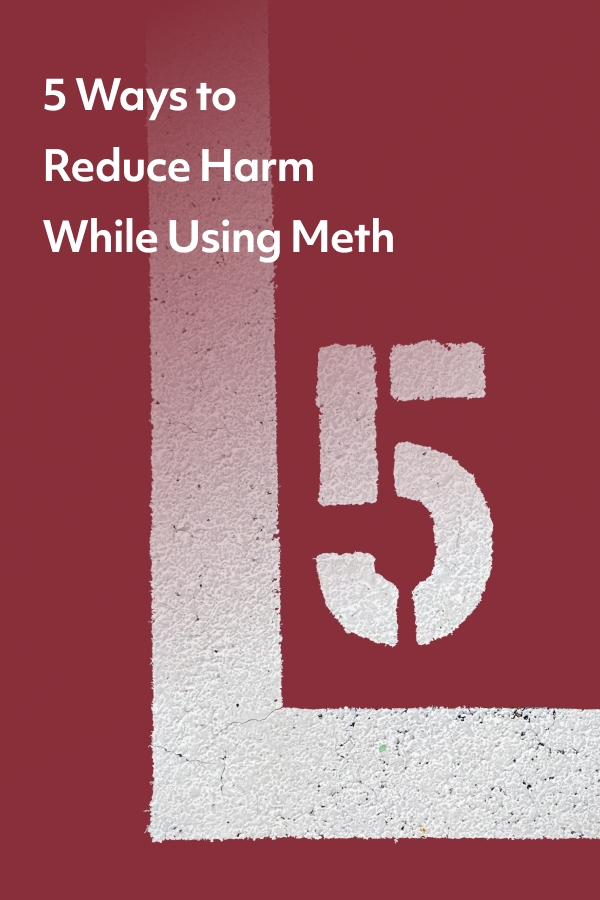As the use of meth accelerates, so do the dangers associated with it. There are harm reduction strategies that can make using methamphetamine less risky.
Methamphetamine-related deaths have soared in recent years by a staggering 46 percent. Unsurprisingly, so have rates of methamphetamine addiction which have risen by over 100 percent. It’s clear that what the country is doing to respond to this surge in deaths is not working. Instead, harm reductionists suggest that we meet people where they are at. That looks like providing strategies to reduce the harm of inevitable drug use.
What is methamphetamine?
According to the National Institute on Drug Abuse (NIDA), methamphetamine (called meth for short), is a powerful, addictive stimulant that targets the central nervous system. Meth is either smoked, taken orally, inhaled, or injected. Given the different types of ingestion, it can look different. Typically it appears as a clear, white, or blue rock (known as crystal meth or ice), a white powder, or a pill.
Meth’s effects are addictive because it creates a sense of euphoria, or “high” by releasing a brain chemical called dopamine. Dopamine is associated with the reward center of the brain because it causes feelings of pleasure and cleverly reinforces the behaviors that provide reward, such as drug use.
The types of effects you can expect from taking meth include:
- Increased alertness and movement
- Decreased appetite
- Rapid or irregular heartbeat
- Faster breathing
- Increased blood pressure and body temperature
- Impulse control
However, its effects are short-lived and this tends to lead to increased use, such as using continuously over several days (known as a “run”) and taking more than they can tolerate (known as overamping).
Longer-term use of meth can cause some more serious effects, such as weight loss, dental decay, addiction, anxiety, hallucinations, paranoia, violent behavior, memory loss, changes to the brain, skin sores, and difficulty sleeping. Another related danger among people who inject methamphetamine is the risk of contracting hepatitis C and HIV. Use of meth can also increase the likelihood of risky behaviors, like unprotected sex, which can also lead to the transmission of sexually transmitted infections.
Methamphetamine use in the United States
According to a recent study in JAMA Psychiatry and CDC data:
- Overdose deaths involving psychostimulants (including meth) have more than doubled in the past decade
- By 2019 meth use increased to 1.7 million Americans
- 15-20 percent of overdose deaths are attributed to methamphetamines
- Rates of methamphetamine use disorder (addiction to meth) rose 33 percent in 2019
- Methamphetamine use is rising among people who misuse opioids
- 50.9 percent of women use methamphetamine, and 49.1 percent of men
- Native Americans and Alaska Natives have the highest rates of methamphetamine use disorder and have also seen a sharp rise in methamphetamine-related deaths
- Black Americans have seen a tenfold increase in methamphetamine use over the past 5 years
- Methamphetamine-related deaths are thought to have surged due to the drug supply becoming contaminated with the powerful opioid fentanyl.
Dr. Nora Volkow, head of NIDA and co-author of the study, told NPR, “In terms of absolute numbers, the group that’s most negatively affected by methamphetamines are American Indians and Alaska Natives and the difference is gigantic.”
Volkow went on to talk about the importance of building resources and interventions that are tailored to the communities that the meth crisis is affecting the most. “We do have behavioral interventions that have been shown to be effective …” and “The ability to provide that support and tailor it to their own cultural needs—that could be beneficial.”
5 Ways to Reduce Harm While Using Meth
It’s important to recognize that many people can’t or don’t want to stop using meth. That being the case, we need to try to reduce the dangers of using. Here are some of the ways to reduce the associated harms of methamphetamine:
- Be cautious of overamping: Drink plenty of water, get enough sleep, and eat regularly. Harm reductionists say it is important to avoid overamping by “start low, go slow.”
- Test drugs before using them: The illicit drug supply is being contaminated with fentanyl, a potentially fatal opioid. People who use meth are unknowingly taking fentanyl, too, dramatically increasing their risk of overdose. It’s critical to use fentanyl test strips to avoid overdose.
- Avoid using alone: Having other people around can decrease the risk of overdose and the chance of overamping. Friends can be supportive and can call for help if you find yourself in a difficult situation.
- Use sterile syringes: Your local harm reduction clinic may be able to provide clean syringes, safe disposal, alcohol wipes, and sterile equipment. This can greatly reduce risk of infection. These clinics can also provide wound care and referrals to other agencies.
- Switch to a safer method of use: Instead of injecting, try snorting or smoking meth instead. It’s important to avoid sharing equipment to reduce the risk of transmitted diseases and bacteria.
You can find many more harm reduction tips at the Drug Policy Alliance and the Harm Reduction Coalition.





